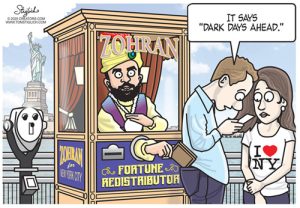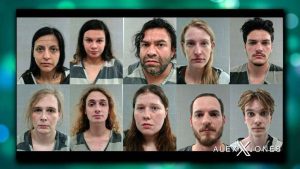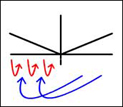“Nicaragua Betrayed” Summary— Chapter 9: The OAS and Deceit
by Edward Ulrich
News of Interest.TV
February 18, 2011
This chapter describes escalations of attacks occuring in Nicaragua being staged from Costa Rica and Panama, and how a commission called the Organization of American States (OAS) was being unfairly exploited against Nicaragua at the direction of those countries as well as by the United States and Venezuela.
Following are key points from the chapter:
— After Sandinista attacks had been repelled during October 1977 in Massaya, San Carlos, and the Honduran border, cleaning-up operations had to be performed and as a result there were many patrols along the border with Costa Rica. The commanders in those border areas were asked to request that Costa Rica notify them when Costa Ricans would be coming across the border, so they would have advance notice and give proper attention to those who would be crossing. The Minister of Security for Costa Rica Mario Charpentier decided to take twenty-five news people on a boat trip down the Rio Frio in order to show them that there were no military operations on the Costa Rican side of the border. As this boat approached the Nicaraguan border, a Nicaraguan plane spotted the boat and the pilot signaled the boat to head to the local check point, but the signal was not heeded due to Charpentier either not being aware of the border crossing directives or choosing to ignore them. After the boat failed to heed the signals, the plane fired two warning rockets that intentionally did not hit the boat, and the boat then immediately returned to Costa Rica.
— Somoza says, “The propaganda which resulted from that incident was unbelievable. The Costa Rican news media claimed that they were attacked and that Nicaragua had used violence against them.” Costa Rica then requested a hearing before the Organization of American States (OAS), which sent a “peace commission” to investigate, and Nicaragua gladly accepted the request thinking that it would give the commission an excellent opportunity to see what was really going on in Nicaragua.
— After the OAS study was completed, they issued a formal report saying that the rockets had been fired from Nicaraguan soil and landed on Costa Rican territory, therefore, Nicaragua was the aggressor. Somoza says:
From that moment forward, I felt the United States was out to get my neck. A member of that committee was the U.S. Deputy Ambassador to the OAS, Robert White. Incidentally, this is the same Robert White who is now U.S. Ambassador to El Salvador. This is the same Ambassador White who issued a statement of great comfort to the Communist Party in May, 1980. From his important position of U.S. Ambassador to El Salvador, he told the world that the problems in El Salvador were being created by the “Right,”and if those people thought that because they were anti-Communist the United States would help them, they were badly mistaken.
— With White on the OAS Commission, it was impossible for Nicaragua to get a fair hearing. As conditions progressively worsened for Nicaragua, they went back to the OAS because they were a founding member of the organization and felt it was their duty to inform it of outside intervention in the domestic affairs of Nicaragua. By this time, the OAS delegate from Venezuela took a strong anti-Nicaraguan posture and heaped verbal abuse against Somoza, Somoza’s family, and Nicaragua, that was unprecedented for the OAS even to this day. This occurance left many members wondering if there was any seriousness to the organization, realizing the importance of the situation.
— It was clear then that Venezuela was violently opposed to Nicaragua, and no one was ready to defend the principals of the OAS and rights of the members. Nicaragua tried to explain to the OAS that they were regularly being invaded from bases in Costa Rica, with people coming across the border raiding, stealing, and burning farms, with the perpetrators then making a quick retreat to Costa Rica; however their complaints were ignored, showing the political motivations of the organization.
— After the border incident but before the OAS meeting, in May 1978 Daniel Oduber stepped down and Rodrigo Carazo stepped in as President of Costa Rica. It was important to Somoza to establish good relations with Carazo because of potential for problems with the country, and he sent his Foreign Minister to meet with him on three different occasions, and once Carazo sent his Foreign Minister to Somoza; but Somoza’s efforts for good neighbor relations with Carazo and Costa Rica failed and the Sandinistas continued their raids into Nicaragua with the knowledge that they had a safe haven in Costa Rica.
— At the OAS meeting, Nicaragua wanted to have a permanent peace commission with military attaches assigned to Nicaragua and Costa Rica. From page 127:
“If you can imagine, Costa Rica said she would not accept military attaches because she had no army. That was a ridiculous answer. The Military Attaches were not going to be there to fight. They were going to be in both countries to observe. It just didn’t make sense to me. It occurred to me, however, that Carazo probably didn’t want them because, to a great degree, the military people were removed from politics and they could recognize guerrilla activity if they saw it. Well, naturally, Carazo didn’t want that. He wanted no military personnel but he did want people who were politically motivated. After the objection from Costa Rica was received, the OAS, in total compliance, decided to send only civilian observers.
The OAS observer team sounded fine to Nicaragua until we saw the makeup of the observer team. We wanted people who could be neutral and impartial, and they proposed anti-Nicaragua people who were also against me personally. One of the delegates on this team of observers was to be from Jamaica, a Socialist country; a delegate from Panama, already our known enemy; a delegate from Columbia, who was later dismissed by his own government for writing a favorable report on Nicaragua; a delegate from Paraguay; and a delegate from one of the small Caribbean nations— I think it was Grenada. I knew that Paraguay would be fair, so the observer team stacked up three to two before it ever came to Nicaragua.
Nonetheless, the team was sent. Early during their stay, they requested to see the controversial border area in Costa Rica. We knew this was the Sandinista sanctuary area from which the terrorists could stage their raids into Nicaragua. Naturally, we thought the team should see the area. Carazo and the Costa Ricans said, “No, you can’t see that area because it is our military reservation.” Now this is the same Costa Rica that didn’t want military observers because she had no army. Yet for some strange reason, she had a military reservation area.
— Somoza first thought it would be very beneficial to have the OAS in Nicaragua even though he recognized Venezuela and the U.S. were against them. He thought it would give Nicaragua a chance to demonstrate to all that they were abiding by the law and doing everything they could to maintain peace and avoid bloody conflict. “In this OAS mission, it was of paramount importance that it be made clear to the world that we were on the receiving end of a revolution being exported from Costa Rica.”
— Somoza says, “The violation of international law was never more apparent. It occurred to me that, based on the actions of the OAS in Nicaragua, one member nation could never again have the due respect of another nation. Each nation, henceforth, could follow its own course and forget international law. It didn’t occur to many of these member nations that they might one day be under attack from an outside force and need the protection of an international judicial body.”
— The violent raids continued despite the OAS observers, and the havoc wreaked by the terrorists ran into the millions of dollars. Steers and cattle stolen in Nicaragua were be sold on the public market in Costa Rica with the knowledge and approval of high ranging members of the Costa Rican government.
— Nicaragua was stuck with the configuration of the OAS, with the cards being stacked against it so much that sanctions would most likely be leveled at them rather than the offending Costa Rica. Nicaragua needed to gauge the attitudes of all the countries in the organization without offending anyone, and most importantly they needed to be cautious of their relationship with Costa Rica— meaning the Sandinista raiders could not be pursued back across the border. Somoza says, “Once more, Nicaragua was abiding by international law. Those who opposed us were not. There were many times when I wanted to engage in hot pursuit of the enemy, and seek out and destroy them. I had to keep telling myself to exercise restraint, exercise restraint.”
— Somoza says, “In looking back, there is serious doubt in my mind that I chose the right course. If we had destroyed the Communists on the Costa Rican border, our nation would most likely still be intact. To be sure, we would have been blasted from ‘hell to breakfast’ by the United States, Venezuela, Panama, Costa Rica, the international press, and even those friendly nations who supported us. As it turned out, being a law-abiding country didn’t pay off. We were blasted anyway, and we lost our country to the Communists.” [Editor’s note— Perhaps Nicaragua engaging in such hostility would have given the country’s attackers more justification to step up their attacks. The global elite were prepared to do whatever it took to make Nicaragua fall. Nicaragua’s best course of action may have been to initiate a massive international information campaign through the production of A/V material such as documentary films and sending spokesmen in order to enlighten the world of the illegal activities of other countries in the situation including the United States.]
— Somoza says, “The agony of that experience will never fade from my mind. I recall sitting in my office in a state of disbelief... I was forced to stand by while all of this was transpiring. The Carter Administration was and the Perez Administration were, in order to achieve their desired results, applying the ultimate international pressure. They were seeking sanctions against Nicaragua, and they were lining up support. On my part, it was time for serious calculating.”
— The OAS had twenty member nations, and it took a two-thirds vote to impose sanctions. An informal count by Nicaragua showed at least nine could be counted on to vote in favor of Nicaragua, and delegates were sent to many nations to present Nicaragua’s case.
— In the meantime, Cuban-trained terrorists were on the offensive in Nicaragua from Costa Rica, and increasingly it was learned that soldiers from other nations were involved, but the news media would only focus on anti-Somoza stories. “... it seemed the news agencies, the news correspondents, and the television networks were all competing to see who could come up with the most vicious anti-Somoza story.”
— Somoza says, “Venezuela was not to be left out. She was demanding to know why evil things were going on in Nicaragua. Venezuela’s questions were always asked in a manner that could leave only one answer. The question presumed the answer. In reality, all of the questions out of Venezuela were positive statements to the effect that my government and I were doing evil things. The raving and ranting never stopped. Then the quotes from Venezuela would be picked up by the wire services and spread all over ...”
— Somoza describes passages from the charter of the OAS which shows that it was designed to condone acts of aggression by one country against another. Following are some of the passages detailed in the book:
The American States establish by this Charter the international organization that they have developed to achieve an order of peace and justice, to promote their solidarity, to strengthen their collaboration, and to defend their sovereignty, their territorial integrity, and their independence . . . .
...
To provide for common action on the part of those States in the act of aggression.
— Somoza says, “There was constant aggression, militarily, economically, and politically, against Nicaragua. Member states, namely Costa Rica and Panama, were directly involved in the military aggression, while the United States was indirectly involved in each form of aggression against the Sovereign State of Nicaragua. Any interpretation of the Charter and existing treaties would unequivocally demonstrate that Nicaragua was the offended State. ... Out of the sad experience with the OAS, one overriding factor emerged — international politics prevailed and not international law.”
Purchase the book “Nicaragua Betrayed” from Amazon.com.








